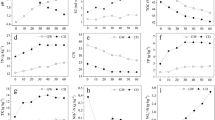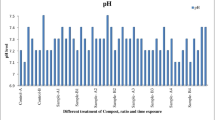Abstract
Efforts have been made to convert the guar gum industrial waste into a value-added product, by employing a new earthworm species for vermicomposting e.g. Perionyx sansibaricus (Perrier) (Megascolecidae), under laboratory conditions. Industrial lignocellulosic waste was amended with other organic supplements (saw dust and cow dung); and three types of vermibeds were prepared: guar gum industrial waste + cow dung + saw dust in 40: 30: 30 ratio (T1), guar gum industrial waste + cow dung + saw dust in 60: 20: 20 ratio (T2,), and guar gum industrial waste + cow dung + saw dust in 75: 15: 10 ratio (T3). As compared to initial concentrations, vermicomposts exhibited a decrease in organic C content (5.0–11.3%) and C:N ratio (11.1–24.4%) and an increase in total N (18.4–22.8%), available P (39.7–92.4%), and exchangeable K (9.4–19.7%) contents, after 150 days of vermicomposting. A vermicomposting coefficient (VC) was used to compare of vermicomposting with the experimental control (composting). P. sansibaricus exhibited maximum value of mean individual live weight (742.8 ± 21.1 mg), biomass gain (442.94 ± 21.8 mg), growth rate (2.95 ± 0.15 mg day−1), cocoon numbers (96.0 ± 5.1) and reproduction rate (cocoons worm−1 day−1) (0.034 ± 0.001) in T2 treatment. In T3 maximum mortality (30.0 ± 4.01 %) in earthworm population was observed. Overall, T2 vermibed appeared as an ideal substrate to manage guar gum industrial waste effectively. Vermicomposting can be proposed as a low-input basis technology to convert industrial waste into value-added biofertilizer.
Similar content being viewed by others
References
Anderson, J. M., & Ingram, J. S. I. (1993). Soil organic matter and organic carbon. In J. M., Anderson, J. S. I., Ingram (Eds.), Tropical soil biology and fertility (pp. 62–66). Wallingford, UK: CAB Internationals
Benitez, E., Saizn, H., Melayar, R., & Nogales, R. (2002). Vermicomposting of a lignocellulosic waste from olive oil industry: A pilot scale study. Waste Management and Research, 20, 134–142
Delgado, M., Bigeriego, M., Walter, I., & Calbo, R. (1995). Use of California red worm in sewage sludge transformation. Turrialba, 45, 33–41
Edwards, C. A., Dominguez, J., & Neuhauser, E. F. (1998). Growth and reproduction of Perionyx excavatus (Perr.) (Megascolecidae) as factors in organic waste management. Biology and Fertility of Soils, 27, 155–161
Elvira, C., Sampedro, L., Benitez, E., & Nogales, R. (1998). Vermicomposting of sludges from paper mill and dairy industries with Eisenia andrei: A pilot scale study’. Bioresource Technology 63, 205–211
Elvira, C., Sampedro, L., Domingnez, J., & Mato, S. (1997). Vermicomposting of water stable sludge from paper pulp industry with nitrogen rich material. Soil Biology and Biochemistry 29, 759–762
Garg, V. K., & Kaushik, P. (2005). Vermistabilization of textile mill sludge spiked with poultry droppings by an epigeic earthworm Eisenia fetida, Bioresource Technology, 96, 1063–1071
Gratelly, P., Benitez, E., Elvira, C., Polo, A., & Nogales R. (1996). Stabilization of sludge from a diary processing plant using vermicomposting. In C. Rodriguez-Barrueco (Ed.), Fertilizers and environment (pp. 341–343). The Netherlands: Kluwer
Gupta, S. K., Tewari, A., Srivastava, R., Murthy, R. C., & Chandra, S. (2005). Potential of Eisenia foetida for sustainable and efficient vermicomposting of fly ash. Water, Air, and Soil Pollution, 163, 293–302
Kale, R. D. (1998) Earthworms: Nature’s gift for utilization of organic wastes In C. A., Edwards (Ed.), Earthworm ecology (pp. 355–373). Ankeny, Lowa St. Lucie Press, New York
Kaushik, P., & Garg, V. K. (2004). Dynamics of biological and chemical parameters during vermicomposting of solid textile mill sludge mixed with cow dung and agricultural residues. Bioresource Technology, 94, 203–209
Lee, K. E. (1992). Some trends opportunities in earthworm research or: Darwin’s children. The future of our discipline. Soil Biology and Biochemistry, 24, 1765–1771
Lorimor, J., Fulhage, C., Zhang, R., Funk, T., Sheffield, R., Sheppard, C., & Newton, G.L. (2001). Manure management strategies/technologies, White paper on animal agriculture and the environment for national center for manure and animal waste management. MWPS, Ames, IA, 52 p (2001)
Maboeta, M. S., & van Rensburg, L. (2003). Vermicomposting of industrially produced woodchips and sewage sludge utilizing Eisenia fetida. Ecotoxicology and Environment Safety, 56, 256–270
Marsh, L., Subler, S., Mishra, S., & Marini, M. (2005). Suitability of aquaculture effluent solid mixed with cardboard as a feedstock for vermicomposting. Bioresource Technology, 96, 413–418
Ndegwa, P. M., Thompson, S. A., & Das, K. C. (2000) Effects of stocking density and feeding rate on vermicomposting of biosolids, Bioresource Technology, 71, 5–12
Nogales, R., Cifuentes, C., & Benitez, E. (2005). Vermicomposting of winery waste: a laboratory study. Journal of Environmental Science and Health B, 40, 659–673
Reddy, K. S., & Shantaram, M. V. (2005). Potential of earthworm in composting of sugarcane byproducts. Asian Journal Microbiology and Biotechnology Environmental Science, 7, 483–487
Satchell, J. E. (1967). Lumbricidae. In A. Burger, F. Raw (Ed.), Soil biology (pp. 259–322). London: Academic Press
Strearns, S. C. (1992). The evolution of life histories. New York, United States: Oxford University press, pp. 72–90
Suthar, S. (2006). Potential utilization of guargum industrial waste in vermicompost production. Bioresource Technology 97, 2474–2477
Suthar, S. (2007a). Vermicomposting potential of Perionyx sansibaricus (Perrier) in different waste Materials. Bioresource Technology, 98, 1231–1237
Suthar, S. (2007b). Nutrient changes and biodynamics of epigeic earthworm Perionyx excavatus (Perrier) during recycling of some agricultural wastes. Bioresource Technology, 98, 1608–1614
Vinceslas-Akpa, M., & Loquest, M. (1997). Organic matter transformation in lignocellulosic waste products composted or vermicomposed (Eisenia fetida andrei): Chemical analysis and C13 CPMAS, NMR spectroscopy. Soil Biology and Biochemistry, 29, 751–758
Walkley, A., & Black, I. A. (1934). An examination of the degtjareff method for determining soil organic matter and prepared modification of the chronic acid titration method. Soil Science 34, 29–38
Acknowledgements
The author is grateful to three anonymous reviewers for valuable comments and careful revision of the manuscript.
Author information
Authors and Affiliations
Corresponding author
Rights and permissions
About this article
Cite this article
Suthar, S. Production of vermifertilizer from guar gum industrial wastes by using composting earthworm Perionyx sansibaricus (Perrier). Environmentalist 27, 329–335 (2007). https://doi.org/10.1007/s10669-007-9032-9
Published:
Issue Date:
DOI: https://doi.org/10.1007/s10669-007-9032-9




